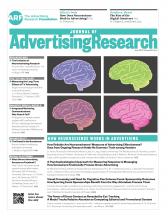ABSTRACT
Many previous studies on attention have ignored the eye-catching potential of “direct context”—the entire promotional and editorial content an observer can view at the same time—in print media. In the current study, characteristics of 183 magazine advertisements and their direct context were coded systematically and linked to eye-tracking data, producing more than 19,000 observations. Expanding on earlier research, the authors focused on fixations within an advertisement during the first five seconds and attention paid to the combined main elements of an advertisement. Results showed that direct context diverted visual attention, especially when featuring multiple colors and large amounts of text.
- © Copyright 2015 The ARF. All rights reserved.
ARF MEMBERS
If you are a member of the Advertising Research Foundation, you can access the content by logging in here
Log In
Pay Per Article - You may access this article (from the computer you are currently using) for 30 days for US$20.00
Regain Access - You can regain access to a recent Pay per Article purchase if your access period has not yet expired.





